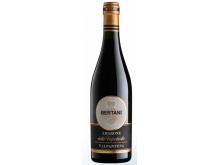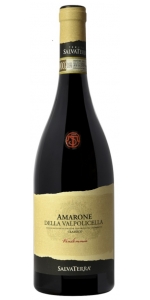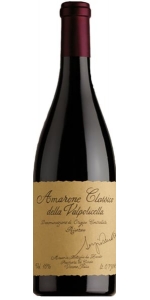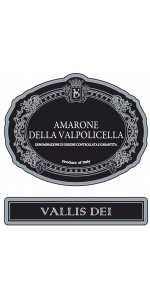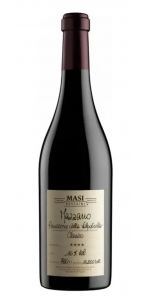Bertani Amarone della Valpolicella Valpantena 2020
Bertani Valpolicella Ripasso Classico Superiore Catullo is made from 70% Corvina Veronese, 20% Corvinone, 10% Rondinella. Valpolicella Classica, Tenuta Novare Estate in Arbizzano di Negrar.
Wine of medium structure with elegant spicy notes of vanilla and chocolate accompanied by typical notes of cherry, sour cherry and white pepper. The palate offers the easy drinkability typical of Valpolicella and, at the same time, silky tannic structure and intense, prolonged aromatic persistence. The finish is fresh, soft and savory. A wine in the classic style, elegant, balanced, harmonious.
Review:
If I was forced to choose a number of wines that can steer the anachronistic Ripasso category into a brighter future, this would be among a very few. A mid-weighted, streamlined expression with just enough fruit on the bones. Think strawberries, lilacs, Asian plums, cloves and a hint of licorice. A noble, almost alpine bitterness lifts the finish. Brilliant. Drink or hold.
-James Suckling 95 Points
Ripa Della Volta Amarone della Valpolicella 70% Corvina, 20% Corvinone, 5% Oseleta and 5% Spigamonte.
The vineyards are located at an elevation of 300-600 metres above sea level, with a south-southwesterly exposure. Training system: Guyot.
It features an intense red color with garnet highlights. The nose offers up a rich variety of aromas with fruity notes of cherries, morello cherries and plums, spices and hints of chocolate. It is round and caressing with soft, mellow tannins balanced by excellent acidity that enhances its drinkability and ageing potential.
It is a wine with a marked personality, great finesse, elegance, and extraordinary longevity.
It pairs well with main dishes such as game and roasts, but also cured meats and mature cheese.
Review:
Strong, dark ruby with a light garnet edge. Intense and very clearly defined nose with notes of ripe plums, dark forest raspberries and some tobacco in the background. Round on the palate with plenty of supple tannin, pleasantly dry, firm pressure in the finish.
-Falstaff 92 Points
Salvaterra Amarone della Valpolicella Classico is made from 65% Corvina, 20% Corvinone, 10% Rondinella, 5% Oseleta.
Perfume of cherries, cocoa, tobacco and black pepper. On the palate it is complex and deep, elegant and robust at the same time, harmonious and with an excellent tannin.
Amarone della Valpolicella Classico is "the essence of the territory", structured but also fresh at the same time.
Pairs with red meats, aged cheese, dark chocolate, cigars.
Review:
Abundant lively red cherries, plums and mellow milk choolate with a energetic and powerful structure, an elegant frame of velvety tannins and an attractive balsamic finish.
-Decanter 96 Points
Ruby red in color, this Amarone Riserva offers dense and smokey aromas of dark cherries, raisins, chocolate, and anise, framed by fruity tannins and a spicy finish. With the level of complexity and balance that this wine shows, it will evolve beautifully for 10+ years.
Review:
Dense garnet, with a nose of walnut husks, toasted black pepper, sour cherries and ash. Smooth and soft on the palate, with a full body and ripe, silky tannins balanced by zesty acidity. Lovely fruit with an extremely long, nutty aftertaste.
-James Suckling 95 Points
Cantina di Verona Amarone Valpolicella Vallis Dei is made from 65% Corvina Veronese, 30% Rondinella, 5% Molinara
Color: deep ruby red
Nose: Dried prune and blackberry with hints of vanilla and spice
Mouth: It is generously structured and velvety.
Yield: 8000 kg of grapes per hectar – after which the grapes are dried “appassimento”
Grapes are raisin-dried for at least 4 months after harvesting, losing at least 40% of their weight. It is made from selected grapes which are left to dry on racks in specially ventilated rooms until the end of winter.
Fermentation temperature between 18° and 22°C
Maceration time: 20 days
Review:
Fresh violets, lilac, wild plums, allspice and wild herbal aromas pour from the glass. The focused palate shows tart cherry preserves, warmed cloves, roasted coffee and dark chocolate that finishes with a crushed chalk minerality. Fine tannins are present but in balance, working with fresh acidity to keep this wine in harmony. Drink now–2045.
-Wine Enthusiast 97 Points
Bertani Valpantena Amarone is made from 80% Corvina Veronese, 20% Rondinella.
The best grapes are selected so that only the healthiest and ripest bunches are sent to the drying rooms in the historic winery at Grezzana, where they are laid out in single-layer crates. In mid- January, the grapes are destemmed and crushed, then fermentation starts, at first at a temperature of 39°F- 41°F, which then reaches 72°F in the final stages.
WINEMAKING
The vines are vertical-trellised and Guyot-trained, with a planting density of 2024 plants per acre. Hand harvest is carried out in the middle of September.
This amarone is produced in the Valpantena hills, north of Verona. The soils are calcareous-marl in the east and calcareous-clay in the west, rich in iron.
TERROIR & VINTAGE NOTES
Bertani’s impact on Veneto wine making, particularly in Amarone production, is so considerable that ‘Bertani’ and ‘Amarone’ are nearly synonymous. Their 150+ year history is dotted with groundbreaking initiatives and royal accreditation. While respectful of their past, Bertani strives towards innovation, using progressive techniques and equipment allied with extensive experience and a deeply felt respect for tradition to provide wines of uncompromising quality.
On the nose, marked and intense aromas of very ripe cherries, sour cherries, spicy and nutty notes typical of the Valpantena. Good follow-through of red fruits on the palate, with supple tannins to give depth. This full bodied wine pairs well with rich dishes, mature cheeses and strong-flavored meats.
Bertani was founded in 1857 by brothers Gaetano and Giovan Battista Bertani. Prosperous wine merchants who believed that quality winemaking held the key to the future, the Bertanis invested their funds in buying some of the finest vineyards in the province and making their own wines. Consequently, unlike many other local producers, Bertani owns its own vineyards and so is able to oversee the entire winemaking cycle from start to finish. Recognition and success followed swiftly as Bertani became one of the first Veronese producers to export its wines on a significant scale. In the early years Bertani spearheaded a campaign to underscore the potential of Verona's Valpolicella Valpantena wine district. The release of its Secco-Bertani Valpantena brand, still in production over 150 years later, is responsible for putting this DOC on the map. The late 1950s saw Bertani take center stage again, with the launch of a new-style Recioto della Valpolicella. Through the introduction of longer aging techniques, this traditionally sweet or sparkling red wine was dramatically transformed into the dry, opulent red we know today as Amarone, one of Italy's most revered red wines. Recent years have been no less eventful. In 1986 an extraordinary cache of 1928 Recioto della Valpolicella Acinatico was discovered, bricked up behind the walls of a farmhouse on a Bertani estate where it had lain undisturbed since the twilight years of World War II. Tastings by experts confirm that the wine's quality remains intact. A superb vintage, as exceptional as it is rare, it is served exclusively at charity events hosted by Bertani. To maintain its extensive vineyards, Bertani engages the skills of some of Italy's most eminent viticulturalists. From its vineyards to its cellars, Bertani offers a fascinating and memorable introduction to Veronese winemaking at its best, where progressive techniques and equipment are allied with extensive experience and a deeply felt respect for tradition.
- back
Quintessa Red 2022 is made from 93% Cabernet Sauvignon, 4% Cabernet Franc, 1% Carménère, 1% Merlot, 1% Petit Verdot.
The 2022 Quintessa is a charming wine, opening with intense aromas of black cherry and cassis that are complemented by notes of tobacco, bay laurel, cedar, and dark chocolate. Plush and inviting on entry, this wine’s flavors align with its aromas. The palate reveals dark fruits and an undertone of crushed rocks, tar, and graphite. On the finish, this vintage displays the signature fine-grained tannin of their Quintessa terroir, backed by voluminous texture and fruit.
Review:
Such an incredible wine here - one of the stars of the September releases. Smells amazing, cooling blueberries with fragrant blackcurrants, edges of florality - totally inviting scents. Full and filling in the mouth, this is ample with such a layered effect, super vertical and elongated. Tight and a little tense but it really works - such balance between black fruit, dried herbs, high acidity and a profound structure. Refined and beautifully presented. So much life, so much energy - this is pure class. A wine you don't want to put down. Feels hands off despite such concentration and power. Ends salty with sticky liquorice, mint and cooling wet stones. You could definitely drink this now but it will age too! 1% Merlot and 1% Petit Verdot complete the blend. One of the final few vintages with Rodrigo Soto at the helm - he stepped down last year to concentrate on his family project Far Mountain in Sonoma Valley which is worth following. Winemaker Rebekah Wineburg.
-Decanter 99 Points
Turley Cedarman Zinfandel is made from 100 percent Zinfandel.
Review:
Blended with 22% Petite Sirah, the 2022 Zinfandel Cedarman hails from Rattlesnake Ridge and Dragon Vineyards high atop Howell Mountain. Medium to deep ruby in the glass, the nose combines extremely ripe black fruits and loamy earth with botanical, herbal notes that meld with floral top notes after time in the glass. The palate follows the fruit-laden foreshadowing of the nose with massive saturation and intensity and transiting to a chewy, sinewy finish lined with juicy acidity nestled into a long, detailed finish. Lovers of a sumptuous style will find much to love upon release, although a few years in the cellar could provide an additional layer of nuance.
-Wine Advocate 94+ Points
Keenly structured and appealingly briary, this Zin is loaded with jammy blackberry, roasted anise and licorice flavors that build toward broad-shouldered tannins.
-Wine Spectator 93 Points

